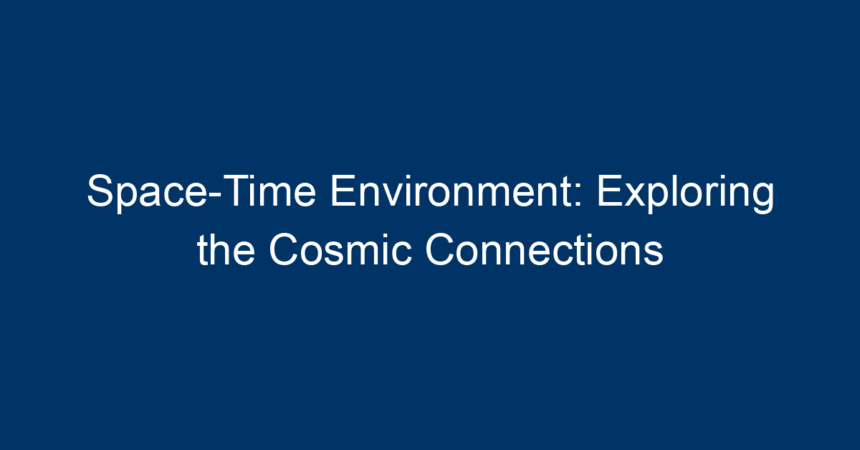The universe is a vast expanse filled with mysteries waiting to be unraveled. Among these mysteries lies the intricate concept of the space-time environment, a framework that intertwines time with the three dimensions of space. This relationship is fundamental to our understanding of the cosmos and affects everything from the orbits of planets to the very nature of gravity itself. In this article, we’ll delve into the essence of the space-time environment, unraveling its relevance in our daily lives and scientific advancements.
Understanding Space-Time
What is Space-Time?
At its core, space-time refers to the four-dimensional continuum that combines the three dimensions of space—length, width, and height—with time as the fourth dimension. This revolutionary idea was introduced by Albert Einstein through his theory of relativity in the early 20th century. In a conventional spatial approach, we usually consider dimensions separately. However, the space-time framework posits that time and space are interconnected.
The Fabric of Space-Time
Imagine space-time as a fabric. Just as a heavy object placed on a soft surface causes a dip, massive celestial bodies like planets and stars warp the space-time environment around them. This curvature explains the gravitational pull these bodies exert on other objects, leading to the trajectories we observe, such as the elliptical orbit of Earth around the Sun.
The Cosmic Implications of Space-Time
Gravity and the Space-Time Environment
One of the most profound implications of the space-time environment is its relationship with gravity. According to Einstein’s general relativity, gravity is not merely a force but a curvature of space-time caused by mass. This insight transformed our understanding of how celestial bodies interact, allowing us to predict the orbits of planets and the paths of comets with remarkable accuracy.
Time Dilation: A Fascinating Phenomenon
Time does not flow at a constant rate everywhere in the universe. This phenomenon, known as time dilation, occurs within the space-time environment and is influenced by speed and gravitational fields. For instance, astronauts aboard the International Space Station experience time slightly slower than those on Earth due to the lesser gravitational pull. This realization has consequences not only for our understanding of time but also for technologies such as GPS, which must account for these differences to provide accurate readings.
Exploring the Space-Time Environment through Modern Technology
The Role of Technology in Understanding Space-Time
Advancements in technology have greatly enhanced our understanding of the space-time environment. The use of particle accelerators, gravitational wave detectors, and high-resolution telescopes allows scientists to study the cosmos in unprecedented detail. For instance, the LIGO (Laser Interferometer Gravitational-Wave Observatory) has confirmed the existence of gravitational waves, ripples in the space-time environment that were first predicted by Einstein.
Black Holes and the Space-Time Environment
Black holes are among the most fascinating phenomena in the universe, formed when massive stars collapse under their own gravity. The space-time environment around a black hole is so warped that not even light can escape its gravitational pull. Studying these enigmatic objects provides insight into extreme conditions and helps scientists understand the limits of our current physics theories.
The Philosophical and Existential Questions
The Nature of Reality
The concept of the space-time environment raises profound philosophical questions about the nature of reality. Are time and space fixed entities, or are they more fluid, influenced by mass and energy? As we explore deeper into the cosmos and our own existence, these inquiries challenge our perceptions and invite us to contemplate the universe’s vast mysteries.
Time Travel and the Space-Time Environment
While often relegated to science fiction, the notion of time travel finds its roots in the space-time environment. Theoretical physicists suggest potential pathways through wormholes or warped space-time that could allow for travel back and forth in time. Although these ideas remain speculative, they ignite imaginative discussions about our understanding of time and existence.
Practical Applications of Space-Time Knowledge
GPS Technology
One of the most tangible applications of our understanding of the space-time environment is in global positioning systems (GPS). These satellites orbiting Earth must account for time dilation, as they experience less gravitational pull than objects on Earth. Without correcting for this difference, GPS readings would quickly become inaccurate, leading to navigational errors in our daily lives.
Advancements in Astrophysics
Astrophysics continues to evolve, driven by our understanding of the space-time environment. From predicting stellar explosions to understanding dark matter and energy, this knowledge fuels research that could unlock the universe’s secrets. Modern telescopes and experimental setups promote discoveries that may lead to revolutionary breakthroughs in physics.
The Future of Space-Time Research
Exploring Beyond Our Solar System
As we advance technologically, the exploration of the space-time environment will lead humanity beyond our solar system. Proposals for advanced space probes like the Breakthrough Starshot aim to explore the nearest star systems, bringing us closer to the exploration of exoplanets and the search for extraterrestrial life.
The Quest for Unified Theories
The ultimate goal in physics is to unify general relativity with quantum mechanics, a feat that would significantly enhance our understanding of the space-time environment. The pursuit of string theory and loop quantum gravity aims to bridge these seemingly disparate realms, opening up new avenues of understanding about the universe’s fabric.
Conclusion: Embracing the Cosmic Connections
The space-time environment is not just a theoretical construct; it profoundly impacts our understanding of the universe and our place within it. As we continue to explore this cosmic tapestry, advancements in technology and scientific thought will unveil new discoveries and insights. Embracing the connection between space and time encourages curiosity and drives innovation in various fields.
Actionable Insights
-
Stay Informed: Keep up with the latest scientific discoveries related to space-time and gravitational phenomena through reputable sources such as scientific journals and documentaries.
-
Engage with STEM: Foster an interest in science, technology, engineering, and mathematics (STEM) in yourself and others. These fields are critical for further understanding the complexities of our universe.
-
Participate in Discussions: Join forums or discussion groups focused on astrophysics or cosmology to share knowledge and engage with like-minded individuals.
- Explore Educational Resources: Utilize online courses and lectures that delve into general relativity and astrophysics for a deeper understanding of the space-time environment.
By cultivating a deeper awareness of the space-time environment, we can all contribute to the ongoing exploration of the universe and the fundamental questions that arise from it. Let’s continue to reach for the stars!




